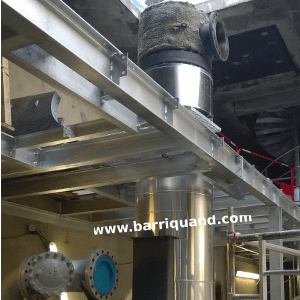Case study: Thermal exchange at the service of the heat networks
ASET tubular heat exchangers were installed in an interconnection substation for the modernization project of the Levallois-Perret heating network.
Case study: Thermal exchange at the service of the heat networks
IDEX, specialized in the realization and the technical management of installations of energy production and distribution, manages the LEVALLOIS heat network through a dedicated company KALITA- through a public service delegation.
A cleaner heating network
Until 2013, the City’s heating network was assured by a mixed gas / fuel boiler situated in the city center (Jules Verne Street). The modernization project planned its replacement by an interconnection substation implanted in Pablo Neruda Street fed by the Paris Heat Network (CPCU) using first and foremost the vapor stemming from the valorization of the UIOM of Saint-Ouen’s household waste and from the use of biomass.
The global, long-term idea is to connect all of Paris’s suburbs to existing factories to create clean heating networks and limit the emission of pollutants in power production.
In this HVAC application, the vapor produced by the CPCU site is transported up to the interconnection station where the heat exchanger transforms it into sanitary hot water to feed the entire city network.
Energy performance according to the rule book
The specifications for this exchange substation planned the implementation of 3 25 MW vertical shell tubes heat exchangers (type BEM) hot vapor / water . The heat exchangers supplied by Barriquand respect TEMA standards (Tubular Exchanger Manufacturers Association), guaranteeing a strong and reliable construction in the long run.
These very voluminous heat exchangers (installed underground on 2 floors) had to, amongst other things, be limited in height. This constraint was respected thanks to the use of smaller, specifically manufactured tubes. This technology allowed us to propose a superior heat exchange surface, thus an increased energy performance (with a pinching of 5 °C, which is remarkable for this technology), while reducing bulkiness. The installation that we supplied also has a spot dedicated to a fourth heat exchanger still to come.

We also chose to add a dilation bellows to our tubular heat exchangers to protect them from thermal shocks (to compensate for dilation differences between the tubes and the shell) and consequently to increase, their lifespan.
Thermal exchange for a sustainable energy
The impact of this type of application in Environmental engineering is especially ecological. To interconnect an exchange substation allows us to use an already existing and successful UIOM factory (Unity of Incineration of Household waste). Thus there is no additional emission of pollution within the city.
Regulation constraints are widely simplified, amongst other things, when compared with regulations that are associated with the use of boilers.For our customer, the profit in terms of maintenance is undeniable: absence of gas or fuel storage, no noise pollution, no smoke, less regulation problems… Besides, the heat exchangers can be piloted remotely and require no human on-the-spot presence, which means a significant economy in operating costs. In this particular case, this substation is managed from the KALITA offices, situated at 500m of the installation.

